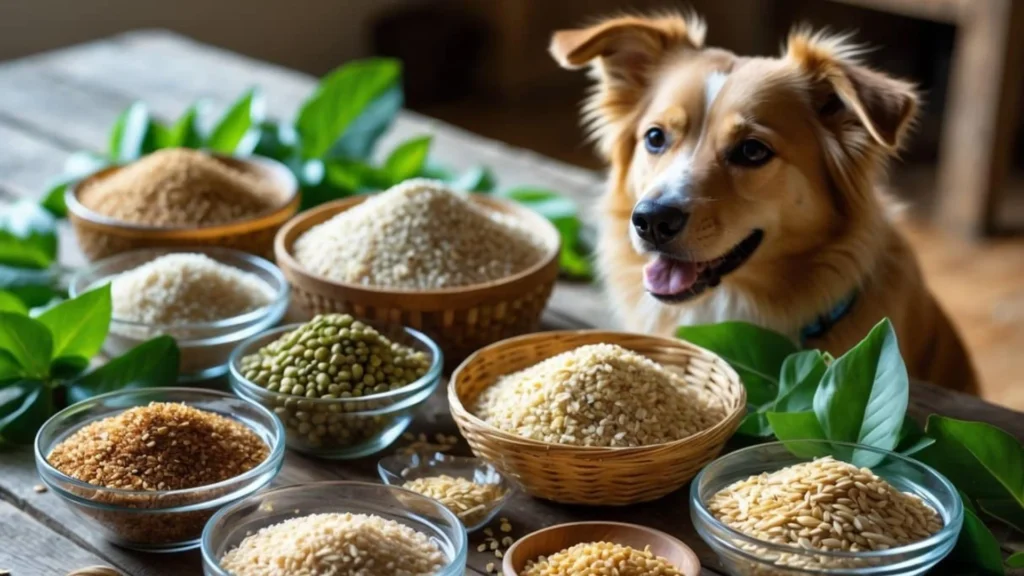In recent years, dog nutrition has become a widely discussed topic, especially with the rise of grain-free diets and their connection to canine heart health.
While some dogs benefit from grain-free formulas due to allergies or sensitivities, many others thrive on diets that include healthy grains.
If you’re considering adding grains to your dog’s food, either to enhance nutrition or to transition from a grain-free diet, it’s essential to know which grains are beneficial, how to prepare them properly, and how to introduce them safely.
In this guide, we’ll walk you through everything you need to know about how to add grains to dog food? Understanding the benefits of grains to practical preparation and feeding tips.
Why Add Grains To Your Dog’s Diet?
Before diving into how to add grains, it’s important to understand why you might want to do it. Despite some misconceptions, grains can be a valuable source of nutrients for dogs. Here are a few key benefits:
1. Excellent Source of Carbohydrates
Grains are rich in complex carbohydrates, which provide sustained energy for dogs throughout the day. This is especially beneficial for active dogs or working breeds.
2. Rich in Fiber
Whole grains add bulk to the diet and aid digestion. Fiber can help regulate bowel movements and promote gut health, especially for dogs prone to gastrointestinal issues.
3. Packed with Vitamins and Minerals
Grains such as oats, brown rice, and quinoa contain essential nutrients like B vitamins, iron, magnesium, and antioxidants that support overall health.
4. Heart Health
Recent research by the FDA has linked some grain-free diets to canine dilated cardiomyopathy (DCM), especially in breeds not genetically predisposed. Including healthy grains in your dog’s food may help mitigate such risks.

How To Add Grains To Dog Food
Recipe Overview
- Preparation Time: 10 minutes
- Cooking Time: 30 minutes
- Total Time: 40 minutes
- Course: Main Course
- Difficulty: Easy
- Cuisine: Homemade Dog Food
- Yield: Approximately 4 cups
Kitchen Utensils
To prepare this grain-inclusive dog food, gather the following:
- Large saucepan or pot
- Large stockpot or Dutch oven
- Cutting board and knife
- Measuring cups and spoons
- Wooden spoon or spatula
- Storage containers or resealable bags
Ingredients
For this recipe, you’ll need:
- 1½ cups brown rice
- 1 tablespoon olive oil
- 3 pounds ground turkey
- 3 cups baby spinach, chopped
- 2 carrots, shredded
- 1 zucchini, shredded
- ½ cup peas (canned or frozen)
How To Add Grains To Dog Food
1. Cook the Brown Rice
In a large saucepan, bring 3 cups of water to a boil. Add the brown rice, reduce the heat to low, cover, and simmer for about 30 minutes, or until the rice is tender and the water is absorbed. Set aside to cool.
2. Prepare the Vegetables
While the rice is cooking, wash and peel the carrots and zucchini. Shred them using a grater or food processor. If you’re using fresh peas, rinse them thoroughly.
3. Cook the Ground Turkey
In a large stockpot or Dutch oven, heat the olive oil over medium heat. Add the ground turkey and cook until browned, breaking it apart with a spoon as it cooks. Ensure it’s fully cooked through.
4. Add the Vegetables
To the cooked turkey, add the shredded carrots, zucchini, chopped spinach, and peas. Stir well to combine. Cook for an additional 5 minutes, allowing the vegetables to soften slightly.
5. Combine with Rice
Add the cooked brown rice to the turkey and vegetable mixture. Stir thoroughly to ensure all ingredients are evenly distributed.
6. Cool and Serve
Allow the mixture to cool completely before serving it to your dog. This ensures it’s safe to eat and won’t cause any discomfort.
Special Notes
❖ Introducing Grains: If your dog has never had grains before, introduce them gradually. Start with small amounts and monitor for any signs of allergies or digestive issues.
❖ Storage: Store any leftover food in an airtight container in the refrigerator for up to 5 days. For longer storage, divide the food into meal-sized portions and freeze.
❖ Portion Size: Adjust portion sizes based on your dog’s size, age, and activity level. Consult with your veterinarian to determine the appropriate amount for your pet.
Health Benefits Of Adding Grains To Dog Food
Adding healthy grains like brown rice, oats, or quinoa to your dog’s meals can boost their diet with essential nutrients. Grains are a great source of fiber, which supports digestive health and helps regulate bowel movements.
They also provide complex carbohydrates for sustained energy, along with important vitamins like B-complex and minerals such as iron and magnesium.
For most dogs, especially active ones, grains can promote a healthier coat, improved energy levels, and better overall well-being. Just be sure to choose whole, unprocessed grains and introduce them gradually.
Frequently Asked Questions (FAQs)
Can all dogs eat grains?
Not all dogs tolerate grains the same way. While most dogs can safely eat grains, some may have allergies or sensitivities. Always introduce grains slowly and consult with your vet if you notice any itching, digestive upset, or behavioral changes.
What are the best grains to add to dog food?
The best grains for dogs include brown rice, oats, quinoa, barley, and millet. These are whole grains packed with nutrients and easy to digest when cooked properly.
How much grain should I add to my dog’s food?
Grains should make up about 20-30% of your dog’s homemade meal. Balance is key—combine grains with lean proteins and vegetables for a complete and nutritious dish.
Should I cook the grains before adding them to my dog’s food?
Yes, always cook grains before serving them to your dog. Raw grains can be difficult to digest and may cause gastrointestinal issues. Cooking softens the grains, making them easier to chew and absorb.
Can grains cause allergies in dogs?
Grain allergies in dogs are rare but possible. If your dog shows signs like itching, ear infections, or stomach upset after eating grains, stop feeding them and speak with your vet for guidance on allergy testing or alternative options.
Final Thoughts
Adding grains to your dog’s diet can offer a host of nutritional benefits when done thoughtfully. The key is to select wholesome, properly cooked grains and introduce them gradually. Every dog is unique, so observe your pet closely and make adjustments as needed.
Whether supplementing a commercial kibble or crafting homemade meals, grains can be a valuable component of a balanced, healthy canine diet.
As always, consult with your veterinarian before making significant dietary changes — especially if your dog has a health condition, food allergy, or special nutritional needs.

Hello dog lovers, I am John. Welcome to my website healthydogfoods.com. I am happy to gain experience from my love for my dog and my pet dog. Through my experience and acquaintance with dog veterinarians, I have made myself a proper guide for dogs. I will tell you about dog care, their nutritious food, their proper safety and dog upbringing for a better life. Even though dogs cannot talk like humans, I will solve all the problems by observing their behavior. I will discuss the proper care and related issues of your dog. Which will give you the right answer to all the problems of your beloved dog.